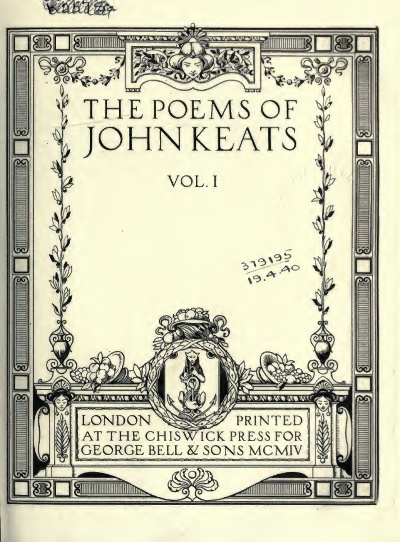John Keats, selected poems Contents
Ways of 'reading' Keats' poetry
 Different contexts of understanding
Different contexts of understanding
- Most critical approaches to Keats focus on purely literary matters: his rich use of language, his mastery of poetic form, his appeal to all the senses
- As Jack Stillinger states below, there has also been much exploration of Keats’ thematic material, especially his meditation on ‘irreconcilable opposites’ such as his ‘melancholy in delight and pleasure and pain’ as well as his ambivalent attitude to natural and artistic beauty both as a source of joy and as a sharp reminder of death
- Most critical studies of Keats also draw heavily on his writing’s biographical, literary and historical contexts.
Amongst more specific current approaches to Keats are the following:
Marxist criticism
A Marxist approach to the poems would consider them as reflections of the political and economic structures of the society in which they were written. The approach would be particularly interested in the brothers in Isabella: or The Pot of Basil as they seem to be archetypal capitalists, ruthlessly exploiting their workers for their own reward:
In torched mines and noisy factories,
And many once proud-quivered loins did melt
In blood from stinging whip …
Some critics have applied Marxist analysis to less obvious poems. For instance, Tom Paulin has argued that the Ode to Autumn is a direct response to the Peterloo massacre which occurred in August 1819. A crowd of 60,000 demonstrators was dispersed by cavalry, who killed eleven people and wounded about five hundred. Paulin sees the deserted field with its smashed flagstaffs and torn banners reflected in the ode’s final stanza:
And touch the stubble-plains with rosy hue:
Then in a wailful choir the small gnats mourn
Among the river sallows, borne aloft
Or sinking as the light wind lives or dies …
According to Paulin, this is an image of a battlefield which offers a coded elegy for the dead reformers, the poem becoming a lament for the defeat of a large army of radicals struck down by the soldiers. This interpretation (downtrodden workers smashed by forces employed by the rich and powerful) is a classic example of the Marxist approach.
A Feminist approach
A feminist approach to Keats' poems would look at the way in which male attitudes to women have shaped how female characters are depicted and their behaviour in Keats’ narratives.
Dangerous women
Some feminist critics have seen Keats as a misogynist who is threatened by the female’s overwhelming sexual and creative presence. For instance, in Lamia it is Lycius’ desire to cling to his love for Lamia (by marrying her) that sets off the events which lead ultimately to his death. Similar ideas occur in La Belle dame Sans Merci: love for a beautiful woman leads to death and destruction. Moreover, it is not only in myth and legend that Keats pursues this theme. In his poem To Fanny Keats is overwhelmed by desire for his beloved, at the same time as wishing to be returned to a calmer state in whichh he was free from 'captivity' to her. In this poem he fears that his love for Fanny threatens to overwhelm his survival as a poet.
Male wish-fulfilment
As a counterweight to the apparent threat of women, Keats generally portrays them as eager to succumb to male attention. Feminists would note the degree of male wish-fulfilment projected onto creations such as:
- Madeline, who adores the uninvited man in her bedroom who ravishes her
- Lamia, who loves 'the tyranny' of Lycias' 'cruel' passion
- The nymph who has been desperate to hide from Hermes yet amazingly 'Bloom'd, and gave up her honey' once caught by him (in the first section of Lamia)
- The Belle Dame who 'moans' in pleasure in response to being garlanded with flowers.
They might also note how Keats' female characters are objectified, praised primarily for their physical allurements, whereas he praises men for their mental capacities and vigour. The women in Keats' poems seem only to exist for the sake of love and as fragile figures to be protected (or ravished) by males. For example, in Isabella: or The Pot of Basil, Isabella is depicted as residing in a 'downy nest' and is described as 'poor, simple Isabella' (unlike her equally besotted lover) who 'By gradual decay from beauty fell,' once robbed of Lorenzo.
Psychoanalytical criticism
The psychoanalytic approach is heavily influenced by the writings of Sigmund Freud. The approach focuses on characters' motivation, in particular investigating 'hidden' desires, fears etc. which may be in conflict with explicitly acknowledged feelings. For instance, Keats experienced much personal loss in his life, especially the loss of his mother and his brother Tom. Some critics have seen in objects such as the Grecian urn, symbols of Keats’ longing for permanence. As Leon Waldoff has said in Keats and the Silent Work of Imagination, the urn symbolises an:
Katharine Wilson has written a psychoanalytic study of Keats called The Nightingale and the Hawk, in which she says of the urn:
According to this reading, the urn epitomises the truth and beauty that resides in the Self, ‘that Self tapping the larger collective unconscious for its images’.
Recently Viewed
Scan and go
Scan on your mobile for direct link.